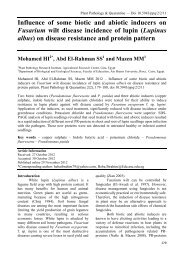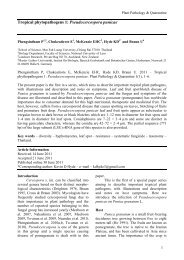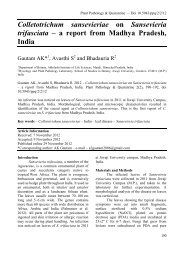Genus Cercospora in Thailand: Taxonomy and Phylogeny (with a ...
Genus Cercospora in Thailand: Taxonomy and Phylogeny (with a ...
Genus Cercospora in Thailand: Taxonomy and Phylogeny (with a ...
Create successful ePaper yourself
Turn your PDF publications into a flip-book with our unique Google optimized e-Paper software.
Fig. 39 – L<strong>in</strong>e draw<strong>in</strong>gs of <strong>Cercospora</strong><br />
citrull<strong>in</strong>a on Citrullus vulgaris. a. Conidiophores<br />
<strong>and</strong> stromata. b. Conidia. Bars = 50 μm.<br />
(Meeboon 2009).<br />
Momordica charantia L. (Cucurbitaceae), 3<br />
August 2008, Jamjan Meeboon (BBH 23754).;<br />
Chiang Mai Prov<strong>in</strong>ce, Mae Jo University,<br />
Farm<strong>in</strong>g area, on leaves of Citrullus vulgaris<br />
Schrad. (Cucurbitaceae), 9 August 2008,<br />
Jamjan Meeboon (BBH 23703).<br />
Hosts – Apadanthera sagittifolia, Ben<strong>in</strong>casa<br />
cerifera, B. hispida, Bryoania sp.,<br />
Bryonopsis lac<strong>in</strong>iata, Citrullus lanatus, C.<br />
vulgaris, Citrullus sp., Cocc<strong>in</strong>ia cordifolia, C.<br />
<strong>in</strong>dica, Ctenolepsis cerasiformis, Ctenolepsis<br />
sp., Cucumis anguria, C. callosus, C. maxima,<br />
C. melo, C. sativa, Cucurbita foetidissima, C.<br />
maxima, C. moschata, C. pepo, C. perennis, C.<br />
sativus, Lagenaria leucantha, L. siceraria, L.<br />
vulgaris, Luffa acutangula, L. aegyptiaca, L.<br />
amara, L. cyl<strong>in</strong>drica, L. vulgaris, Melothria<br />
pendula, Momordica charantia, M. coch<strong>in</strong>ch<strong>in</strong>ensis,<br />
M. cordifolia, M. dioica, M. foetida,<br />
M. schimperiana, Sechium edule, Sicana<br />
odorifera, Telfaria pedata, Trichosamthes<br />
angu<strong>in</strong>a, T. japonica (Cucurbitatceae) (Crous<br />
& Braun 2003).<br />
Distribution – Worldwide, where the host<br />
plants are cultivated or grow<strong>in</strong>g, <strong>in</strong>clud<strong>in</strong>g<br />
Plant Pathology & Quarant<strong>in</strong>e<br />
American Samoa, Argent<strong>in</strong>a, Austria,<br />
Bangladesh, Barbados, Belize, Bolivia, Brazil,<br />
Brunei, Bulgaria, Cambodia, Canada, Chile,<br />
Ch<strong>in</strong>a, Cook Isl<strong>and</strong>s, Costa Rica, Cuba, Czech<br />
Republic, Denmark, Dom<strong>in</strong>ican Republic, El<br />
Salvador, Ethiopia, Fiji, French Polynesia,<br />
Gabon, Georgia, Germany, Ghana, Great<br />
Brita<strong>in</strong>, Greece, Guam, Hong Kong, India,<br />
Indonesia, Iran, Iraq, Irel<strong>and</strong>, Israel, Israel,<br />
Italy, Jamaica, Japan, Kenya, Korea, Laos,<br />
Malawi, Malaysia, Mauritius, Mexico,<br />
Morocco, Myanmar, Nepal, Netherl<strong>and</strong>s, New<br />
Caledonia, New Zeal<strong>and</strong>, Nicaragua, Nigeria,<br />
Norway, Pakistan, Panama, Papua New Gu<strong>in</strong>ea,<br />
Peru, Philipp<strong>in</strong>es, Pitcairn Isl<strong>and</strong>, Pol<strong>and</strong>,<br />
Puerto Rico, Romania, Russia, Samoa, Saudi<br />
Arabia, Solomon Isl<strong>and</strong>s, Somalia, South<br />
Africa, Sri Lanka, Sweden, Switzerl<strong>and</strong>, Sudan,<br />
Taiwan, Tanzania, <strong>Thail<strong>and</strong></strong>, Togo, Tonga,<br />
Tr<strong>in</strong>idad <strong>and</strong> Tobago, Ug<strong>and</strong>a, Ukra<strong>in</strong>e, UK,<br />
USA, Vanuatu, Venezuela, Virg<strong>in</strong> Isl<strong>and</strong>s,<br />
Zambia, Zimbabwe (Crous & Braun 2003).<br />
Notes – Sechium edule is reported here as<br />
a new host of C. citrull<strong>in</strong>a. <strong>Cercospora</strong><br />
citrull<strong>in</strong>a was previously reported from<br />
<strong>Thail<strong>and</strong></strong> by Petcharat & Kanjanamaneesathian<br />
(1989), <strong>and</strong> Meeboon et al. (2007b) on<br />
Cocc<strong>in</strong>ia gr<strong>and</strong>is. Crous & Braun (2003)<br />
considered this species as C. apii s. lat.<br />
Literature – Chupp (1954, p. 185), Ellis<br />
(1976, p. 255).<br />
<strong>Cercospora</strong> cocc<strong>in</strong>iae Munjal, Lall & Chona,<br />
Indian Phytopathol. 12: 86 (1959). Fig. 40<br />
Leaf spots 1–5 mm diam., amphigenous,<br />
scattered to confluent, dist<strong>in</strong>ct, circular to<br />
subcircular, pale to pale brown, greyish brown<br />
to greyish white at the center, <strong>with</strong> dist<strong>in</strong>ct,<br />
yellowish brown to dark brown marg<strong>in</strong>s.<br />
Caespituli epiphyllous, rarely amphigenous.<br />
Stromata 18–29.5 μm diam., small, sometimes<br />
rudimentary to poorly developed, composed of<br />
a few sub-globular to irregular, brown to dark<br />
brown cells. Conidiophores 18–108.5 × 3–5.5<br />
μm, very variable <strong>in</strong> length, 4–15 <strong>in</strong> divergent<br />
fascicles, 1–9-septate, aris<strong>in</strong>g from stromata<br />
through the cuticle, pale olivaceous brown,<br />
sometimes paler at the apex, straight to slightly<br />
curved, unbranched, strongly geniculate. Coni-<br />
diogenous cells <strong>in</strong>tegrated, term<strong>in</strong>al, holoblastic,<br />
mostly polyblastic, sympodially proli-<br />
57









